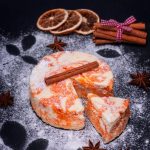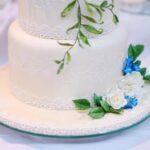When to use royal icing for cake decorating is a crucial decision that can greatly impact the final look and appeal of your baked creations. Royal icing is a versatile and popular choice for decorating cakes due to its smooth finish and ability to hold intricate designs.
Royal icing is a type of frosting made from powdered sugar, egg whites, and sometimes lemon juice or cream of tartar. It sets hard, making it ideal for creating delicate decorations like flowers, lacework, and piped details on cakes. Unlike buttercream or fondant, royal icing dries quickly once applied to the cake, providing a firm base for intricate designs.
The beauty of royal icing lies in its versatility in cake decorating. From simple borders and lettering to elaborate 3D designs, royal icing can be used in a variety of techniques to achieve different looks and textures on cakes. Whether you’re looking to add a touch of elegance with delicate piping or create bold statement pieces with stenciling, royal icing offers endless possibilities for creative expression in cake design.
What Is Royal Icing and How Is It Different From Other Types of Frostings?
Royal icing is a popular choice for cake decorating due to its versatility and ability to create intricate designs on cakes, cookies, and other baked goods. Made from powdered sugar, egg whites, and sometimes lemon juice or cream of tartar, royal icing dries hard, making it perfect for creating decorations that hold their shape.
Unlike buttercream or cream cheese frosting, royal icing does not have a creamy texture and is best suited for detailed work like piping borders, flowers, and lettering.
One key difference between royal icing and other types of frostings is its consistency. Royal icing can be adjusted to different consistencies by adding more or less water. A thicker consistency is ideal for outlining designs or creating intricate details that need to hold their shape. On the other hand, a thinner consistency is perfect for flooding cookies or creating smooth surfaces on cakes.
In addition to its ability to dry hard and hold intricate designs, royal icing also has a longer shelf life compared to other frostings. Once dried, royal icing decorations can last for weeks if stored properly in an airtight container away from humidity. This makes it a great choice for making decorations ahead of time or for shipping baked goods without worrying about them getting damaged in transit.
| Royal Icing Consistency | Best Use |
|---|---|
| Thick consistency | Outlining designs or creating intricate details. |
| Thin consistency | Flooding cookies or creating smooth surfaces on cakes. |
The Versatility of Royal Icing in Cake Decorating
Royal icing is a popular choice for cake decorating due to its versatility and ability to create intricate designs on cakes and cookies. One of the main advantages of royal icing is its quick-drying properties, which allows decorators to build intricate designs with ease. The smooth texture of royal icing makes it ideal for creating borders, writing messages, and making delicate flowers and decorations.
When to use royal icing for cake decorating depends on the desired outcome of the design. Royal icing is commonly used for decorating wedding cakes, cookies, gingerbread houses, and cupcakes. It can also be used for creating intricate piping details on special occasion cakes such as birthdays, anniversaries, and holidays. Whether you want to create elegant lace patterns or whimsical cartoon characters, royal icing offers endless possibilities for cake decoration.
Royal icing can be colored using gel food coloring to achieve vibrant shades that will not fade or bleed into the cake. This makes it perfect for creating colorful designs and intricate patterns. Additionally, royal icing can be thinned down with water to create different consistencies for flooding cookies or creating dimensional decorations. With practice and patience, decorators can master the art of using royal icing to enhance their cake decorating skills.
| Royal Icing Usage | Description |
|---|---|
| Wedding Cakes | Ideal for intricate designs and delicate decorations. |
| Cookies | Perfect for flooding and piping designs on sugar cookies. |
| Cupcakes | Great for adding detailed decorations on top of cupcakes. |
When to Use Royal Icing
Royal icing is a popular choice for cake decorators due to its versatility and ability to create intricate designs. Knowing when to use royal icing for cake decorating can elevate your creations and add a professional touch to your baked goods. Here, we’ll explore different cake decorating techniques where royal icing shines.
Piping Designs
One of the most common uses of royal icing in cake decorating is for piping designs. Whether you’re creating intricate lace patterns, delicate flowers, or personalized messages on cakes, royal icing provides the perfect consistency for precision piping. Its ability to hold its shape once dried makes it ideal for creating detailed decorations that will impress your guests.
Flood Decorating
Another technique where royal icing excels is flood decorating. This involves using a thinner consistency of royal icing to cover larger areas of a cake with a smooth, even layer. By flooding the surface with royal icing and allowing it to set, decorators can then add additional designs and details on top. This technique is commonly used for creating colorful backgrounds or adding texture to cakes.
Runouts and Transfers
Royal icing can also be used for creating runouts and transfers in cake decorating. Runouts involve piping a design onto parchment paper or acetate sheets, allowing it to dry completely, and then transferring it onto the cake. This technique is often used for creating intricate shapes or patterns that are difficult to achieve directly on the cake itself. Royal icing’s firm texture makes it perfect for creating sturdy decorations that can be easily transferred without breaking.
By understanding these different cake decorating techniques where royal icing is best utilized, you’ll be able to take your creations to the next level. Experimenting with piping designs, flood decorating, runouts, and transfers can help you discover new ways to use royal icing in your cake decorating projects and unleash your creativity in the kitchen.
Tips and Tricks for Working With Royal Icing
Royal icing is a popular choice for cake decorators due to its versatility and ability to create intricate designs. However, working with royal icing can sometimes be challenging, especially for beginners. Here are some tips and tricks to help you master the art of working with royal icing when decorating cakes.
Consistency Is Key
One of the most important aspects of working with royal icing is achieving the right consistency. Royal icing can be adjusted to different consistencies depending on the technique you are using. For outlining and piping details, you will want a thicker consistency, while flooding or covering larger areas requires a thinner consistency. To achieve the desired consistency, add small amounts of water or powdered sugar until you reach the right texture.
Keep Your Tools Clean
To prevent your royal icing from getting contaminated and affecting your designs, it’s essential to keep your tools clean at all times. Make sure to wash your piping tips, spatulas, and bottles thoroughly before each use. Any residue left from previous projects can ruin the appearance of your new design.
Practice Makes Perfect
Working with royal icing takes practice, so don’t get discouraged if your first few attempts are not perfect. Experiment with different techniques and designs to improve your skills. The more you work with royal icing, the better you will become at handling it and creating beautiful decorations on cakes effectively.
By following these tips and tricks for working with royal icing when decorating cakes, you’ll be able to enhance your cake decorating skills and create stunning designs that will impress everyone who sees them. Remember that practice makes perfect when it comes to working with royal icing, so don’t be afraid to experiment and try new things in your cake decorating projects.
Common Mistakes to Avoid When Using Royal Icing
When it comes to using royal icing for cake decorating, there are some common mistakes that inexperienced bakers may make. By being aware of these pitfalls, you can ensure that your cake decorating projects turn out beautifully. Here are some key mistakes to avoid when working with royal icing:
- Not Consistency Testing: One of the most important aspects of working with royal icing is getting the consistency just right. If the icing is too thick, it will be difficult to pipe intricate designs. On the other hand, if it is too thin, it won’t hold its shape on the cake. It’s essential to perform a consistency test by piping a small amount onto a plate and observing how it behaves.
- Rushing the Drying Process: Royal icing needs time to dry and set properly. One common mistake is not allowing enough time for each layer or element to dry before adding another on top. This can result in smudged or collapsed decorations. Patience is key when working with royal icing.
- Using Greasy Tools or Surfaces: Royal icing does not mix well with oil or grease, as it can break down the consistency of the icing. Make sure your tools, piping bags, and work surfaces are clean and grease-free before using royal icing. This will help your decorations stay crisp and intact.
By avoiding these common mistakes and paying attention to detail in your cake decorating process, you can achieve stunning results with royal icing. Don’t get discouraged if you encounter challenges along the way – practice makes perfect when it comes to working with this versatile frosting.
Royal Icing Recipe and How to Make It at Home
Royal icing is a versatile and classic frosting that is commonly used in cake decorating. It is known for its smooth finish and ability to hold intricate designs, making it a popular choice for decorating cookies, cupcakes, and cakes for special occasions. Learning how to make royal icing at home can be a game-changer for bakers looking to elevate their confectionery creations.
To make royal icing at home, you will need just a few simple ingredients: powdered sugar, egg whites or meringue powder, and water. Here is a basic recipe to get you started:
- 2 cups of powdered sugar
- 2 tablespoons of meringue powder
- 3 tablespoons of water
To prepare the royal icing, simply combine the powdered sugar and meringue powder in a mixing bowl. Gradually add water while mixing until you reach your desired consistency. For flooding and outlining purposes, you may need different consistencies of royal icing – thicker for outlining and thinner for flooding intricate designs.
Once you have achieved your desired consistency, transfer the royal icing to piping bags fitted with various tips depending on the design you are going for. Practice piping on parchment paper or wax paper before moving on to decorating your baked goods. Royal icing can also be colored using gel food coloring to achieve vibrant hues for your decorations.
Conclusion
In conclusion, royal icing is truly a must-have for cake decorating due to its unique properties and versatility. Whether you are looking to create intricate designs, delicate details, or even sturdy structures on your cakes, royal icing provides the perfect solution. Its ability to dry hard makes it ideal for creating decorations that hold their shape and stay in place. Additionally, its smooth and clean finish adds a professional touch to any cake design.
When to use royal icing for cake decorating ultimately depends on the specific technique or design you want to achieve. From piping intricate lace patterns to creating 3D decorations like flowers or figurines, royal icing offers endless possibilities. Its ability to dry quickly also makes it a great choice for those who need decorations to set firmly in place without worrying about smudging or smearing.
Lastly, mastering the art of working with royal icing may take some practice, but the results are definitely worth it. By following tips and tricks such as using a consistent consistency, utilizing different piping tips for various effects, and practicing patience when letting decorations dry, you can elevate your cake decorating skills with royal icing. So next time you’re planning a special cake project, consider using royal icing to take your creations to the next level.
Frequently Asked Questions
How Far in Advance Can You Decorate a Cake With Royal Icing?
Decorating a cake with royal icing can be done as far in advance as a few days before serving. Since royal icing dries hard, it helps preserve the decorations and keep them intact for longer periods of time compared to other frostings.
Why Do We Use Royal Icing Instead of Buttercream When Decorating?
Royal icing is preferred over buttercream for decorating because of its smooth finish and ability to hold intricate designs without melting or losing shape. It also dries quickly, allowing for easier handling and transportation of decorated cakes without smudging.
Can You Use Royal Icing to Decorate a Cake?
Royal icing is commonly used to decorate cakes due to its versatility in creating intricate designs, such as flowers, borders, and lettering. Its smooth consistency makes it ideal for piping and flooding techniques, allowing decorators to achieve professional-looking results.

Welcome to my blog about home and family. This blog is a place where I will share my thoughts, ideas, and experiences related to these important topics. I am a stay-at-home mom with two young children. I hope you enjoy reading it! and may find some helpful tips and ideas that will make your home and family life even better!





